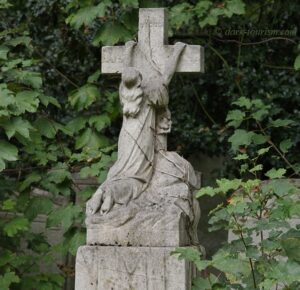As Europe is heading into summer, and before long quite probably into another series of heatwaves, I thought I’d post something about my visit to the great city of Krakow, Poland, where I was in mid-January, i.e. in the depths of the southern Polish winter. This became clear already on the train journey from Vienna … as soon as the train entered Poland the view from the window was often something like this:

It was indeed bitter cold (minus 15 degrees Celsius on the day I arrived) and there was a good layer of snow – as some of my readers may already have seen in the earlier post about Auschwitz that I uploaded on International Holocaust Remembrance Day (27 January). But after visiting Auschwitz I also had a few days in Krakow itself and managed to fill a number of significant gaps in terms of dark tourism that I’ll present in the course of this Blog post.
The biggest of these gaps was probably the museum inside the former Schindler factory. This is associated with the story of Oskar Schindler, who managed to save about a thousand Jews from the Holocaust, as depicted in the 1993 blockbuster movie “Schindler’s List” directed by Steven Spielberg and shot largely in Krakow. The original buildings of the former enamel factory survived WWII and I remember seeing it on my first visit to Krakow in 2008, when the factory site was still off limits. A few years later, however, a substantial museum opened inside the administrative tract. This is what the building, with its iconic gate, looks like from the outside today:

In January this year, I finally had a chance to see the huge exhibition inside. Note that this is not just about Oskar Schindler and his actions – that’s actually only a small aspect in the museum (I’ve heard people say “too small”). Instead the exhibition is entitled “Krakow under Nazi Occupation 1939-1945”. And even that is too narrow a designation as the exhibition actually also covers the period before WWII. The layout of the exhibition is a bit confusing in places and the museum is rammed full of a wide range of installations, including a reconstruction of the ghetto wall, cramped ghetto apartments, trams, tanks and whatnot, as well as featuring countless screens and text-and-photo panels in addition to amassed smaller artefacts. It can be a little overwhelming, seem overloaded and certainly requires a lot of time. But it is now probably Krakow’s most significant Nazi-era-related institution. In the (comparatively small) section about Oskar Schindler you can see his desk and an enamel-themed art installation:

The site is quite near the area in the Podgorze district where the Jewish ghetto of Krakow was established in March 1941. En route to the Schindler factory I revisited the stretch of the original ghetto wall that survives to this day:

Also in Podgorze is Plac Bohaterow Getta with its intriguing ghetto memorial consisting of a couple of dozen steel chairs neatly arranged across the square. These symbolize the furniture that the Nazis often chucked out of windows during the liquidation of the ghetto in March 1943.

In the south-western corner of the square is the old Eagle Pharmacy (Apteka Pod Orłem in Polish), which has been turned into a small museum, mainly about the role of the Pole who ran the pharmacy, helping ghetto inhabitants not just with meds but also in many other ways. The inside features a reconstruction of the main dispensing desk and shelves:

The Schindler factory and the Eagle Pharmacy form part of a “memory trail” advertised by the Krakow Historical Museum. The third element in this is the former Gestapo headquarters on Pomorska Street. Here another exhibition about the occupation of Krakow and the Nazi reign of terror has been set up, though it also covers post-war Stalinist repression, show trials and deportations to the gulags. The star piece of the site, however, are parts of the preserved original cells in the basement, where dozens of inscriptions left by inmates sentenced to death can still be seen. Here’s a photo of the grim cell tract with the original doors:

I hadn’t even known about the Pomorska site yet when I set off for Krakow and only found out about it when I came across a leaflet about that “memory trail”, but I managed to slot in a visit.
Another thing I had planned to do all along was visiting Płaszow, the site of the former concentration camp that also featured in the movie “Schindler’s List”, although I knew that there wouldn’t be much to see other than a few monuments and plaques. Here’s a photo of the main monument from the 1960s, i.e. erected during the communist era (and it’s quite typical for that, in fact it reminded me a bit of Salaspils):

Of the actual camp structures nothing remains, everything was razed to the ground by the Nazis towards the end of the war before they retreated. An exception is the so-called Grey House. This was a building appropriated by the Nazis from its Polish residents and turned into the command centre for the Płaszow camp. That is to say: this was the workplace of the infamous camp commandant Amon Göth, who was so chillingly portrayed by actor Ralph Fiennes in “Schindler’s List”. When I was there I found the house fenced off and lots of construction work was going on in and around it. As a sign on one of the fences indicated, the Grey House is now being converted into a museum as well!

Incidentally, I saw only one of the open-air historical information panels I had read about. Indeed, these were being replaced by new ones when I was there. Meanwhile this new open-air exhibition with panels dotted all over the former grounds of the camp has reopened. So I have good reasons for another return visit at some point.
The same also applies to the nearby Liban quarry. This was where camp inmates had to do the hardest of forced labour. It was abandoned after the war; but when Spielberg made “Schindler’s List” in Krakow he used the quarry site as a film set, namely for a reconstruction of the Płaszow camp. Allegedly you can still find remnants of the film set such as parts of the mock-up of the camp fences and a replica of a road made from broken up headstones from the Jewish cemeteries that the camp was built on. When I was there, however, I couldn’t venture down into the quarry due to the snowy weather. It just wouldn’t have been safe. So I could only look in from the southern rim and see the abandoned industrial relics at the bottom from a distance:

I will have to go back and try to explore the quarry on another revisit – then in less adverse weather, hopefully.
What I did manage to do on this occasion, though, was to go on a private guided tour of Nowa Huta. That’s the Stalin-era new town built next to the giant Lenin steelworks constructed in the early 1950s. The name was changed after the fall of communism, of course, and the Lenin statue in the middle of the square that also bore his name was removed. But these days Nowa Huta exudes a certain retro charm and that is being exploited by communism-themed tours that even take visitors there by vintage cars from that era. Ours was this GDR-built “Trabbi”:

The tour took in various parts of Nowa Huta, including the central square where the Lenin statue once stood (same photo as the one featured at the top of this post):
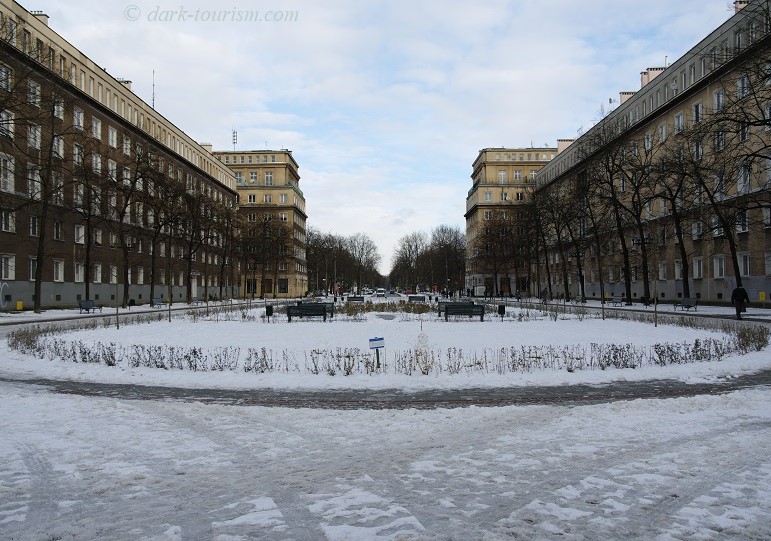
By the entrance to the steelworks, whose capacity these days is but a fraction of what it used to be, stands the name of the plant, which was sold into the hands of an Indian company in 2005, and is no longer named after Lenin but after a Polish scientist and engineer:
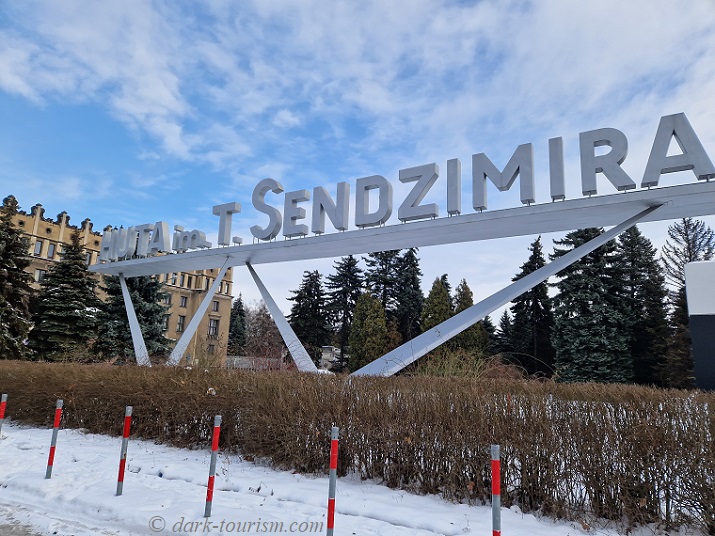
On the left you can see a little bit of the palatial administrative buildings of the steelworks, now also largely abandoned. But our tour included a visit to the command-centre nuclear shelter underneath one of them. In the meantime I have found out that there are also tours of the building above, a dedicated Nowa Huta Museum and associated with that yet another nuclear shelter. Yet more reasons for another return visit to Krakow!
Back in central Krakow I finally visited the main mainstream sight of the city (which I had given a miss on my first visit), namely the Wawel Hill with its former royal palace and the main cathedral that is the seat of the archbishop of Krakow (the best known one was Karol Wojtyla, later Pope John Paul II). Here’s a photo of the snowy square at the top of Wawel Hill:
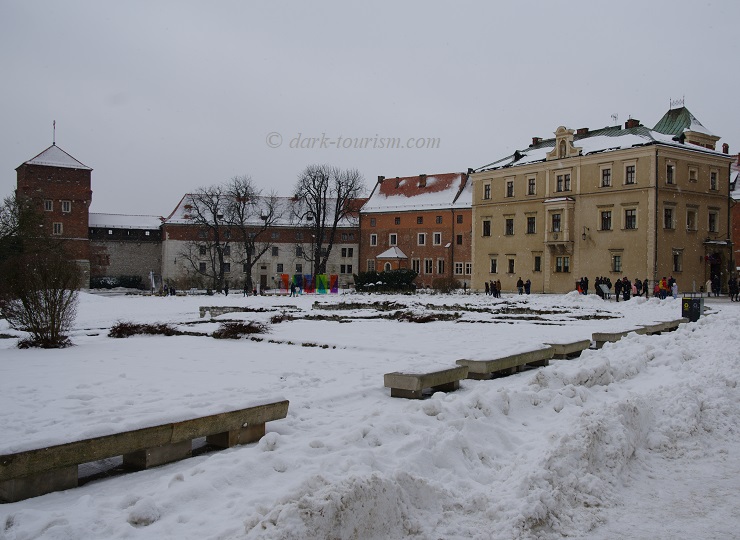
My wife also talked me into paying to go inside the cathedral and the crypt underneath. That at least gave it a dark element. Amongst the many eminent Poles who have found their final resting place here is Lech Kaczynski, who was killed in a plane crash near Smolensk in 2010. He lies in a totally OTT sarcophagus. To my annoyance, photography inside was forbidden so I had to keep my dSLR dangling idly from my shoulder. But when we came across the sarcophagus of General Władysław Sikorski in a quite corner we sneaked in a surreptitious snap by smartphone:

Sikorski was a leader of the Polish government in exile during WWII and his life ended tragically and mysteriously, namely in a plane crash off Gibraltar in 1943. The exact cause of the crash has never been ascertained 100%, and suspicions remain that either the Soviet or even the British secret service may have had a hand in it …
We visited the old Jewish quarter of Kazimierz as well, and even had meals in two of the Jewish restaurants there. All over the district you encounter Jewish symbols, such as this fence made from menorah shapes:

A final thing I had long wanted to see from closer up was the abandoned former Forum Hotel on the southern banks of the Vistula River:
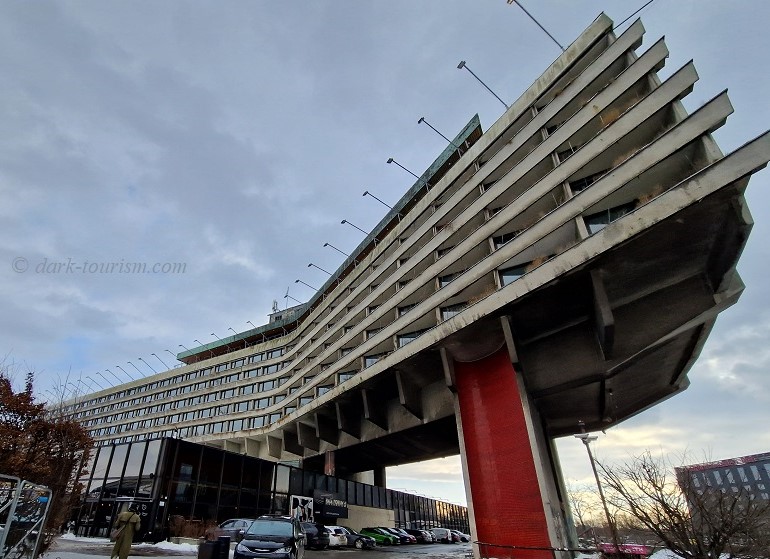
The hotel, built in the communist era and back then the most modern such place in the country, was closed in 2002, allegedly due to some construction faults. It’s still standing, though, and the ground floor now houses a food hall, bars and clubs and as such has become quite a social hub for the locals. The floors above with the abandoned guest rooms, however, are unfortunately not accessible.
At least there are no longer the giant billboards that used to cover the entire front facade. Now you can see that plants are growing on the balconies! The billboards were banned by the city administration a while ago, as our Nowa Huta guide reported. She also told us that after the funeral of Lech Kaczynski there was a billboard here advertising a beer brand also called Lech simply as “Zimny Lech”, which means ‘cold Lech’!
Sometimes dark finds you even when you’re not looking for it. And occasionally this can be very current dark things. In Kazimierz we walked past an Israeli Jewish institution and encountered these posters calling for the release of the Israeli hostages kidnapped by Hamas on 7 October last year, which in turn sparked a brutal Israeli military campaign in the Gaza Strip, a situation that is still ongoing.
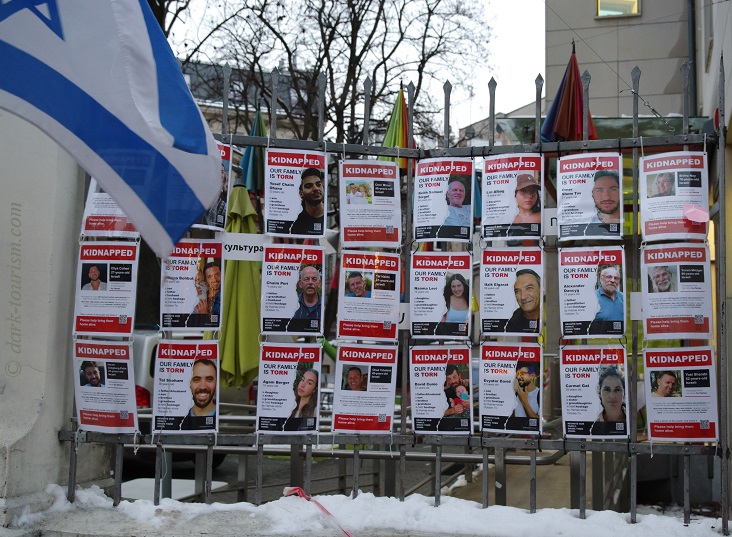
And another ongoing military tragedy, Putin’s war of aggression against Ukraine, we were reminded of on the main square of Krakow’s Old Town, the Rynek Głowny. Here we saw every day a group of people waving Ukrainian and Polish flags in solidarity and collecting donations for Ukraine.
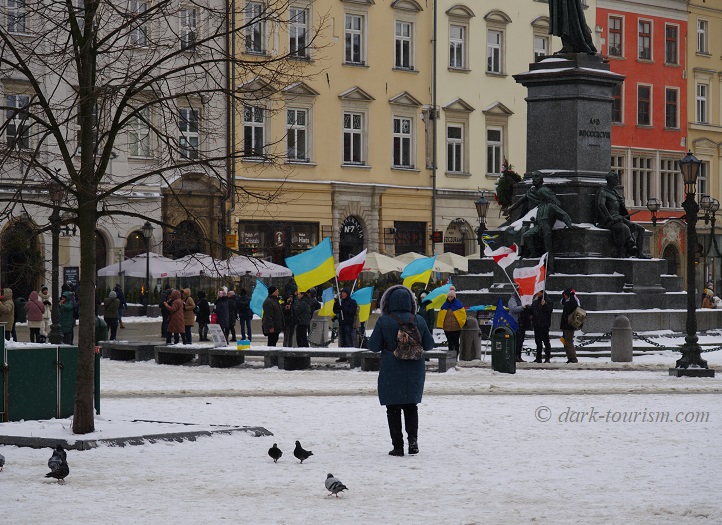
But as the final image for this post I’ve chosen another photo of Rynek Głowny, this time by night and in its full Christmassy glory (in many places Christmas trees and decorations stay up in Poland until ‘Candlemas’, 2 February).

But so much for this Krakow post.
I’ve also written an all-new chapter on Krakow for my main website, together with a few subchapters (Eagle Pharmacy, Pomorska, and Płaszow). I’m still working on further subchapters, including ones for the Schindler factory and Nowa Huta …
BUT: I won’t be able to upload those for a while, because my main website is currently undergoing some technical maintenance and software updates. During that time the site may also not function fully and smoothly, as there are always problems arising during such updates that need ironing out. But I hope we will get there in the end and that you’ll appreciate the slightly altered design. Check back in a few weeks’ time.



